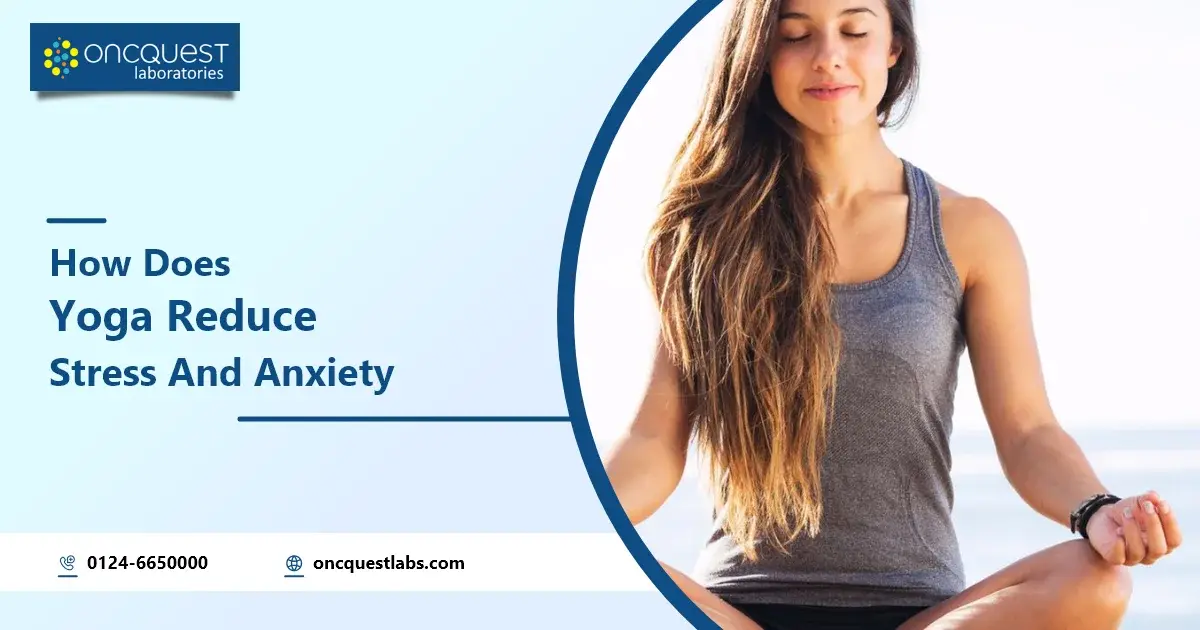In our fast-paced and demanding world, stress and anxiety have become unwelcome companions for many. The relentless daily grind, mounting responsibilities, and a constant digital connection can leave us feeling overwhelmed and mentally exhausted. The good news is that amidst this chaos, there exists a serene sanctuary that offers solace and respite – yoga.
Yoga, an ancient practice with roots tracing back thousands of years, is not merely a physical exercise but a holistic approach to well-being. It has gained remarkable recognition for its capacity to reduce stress and anxiety, offering a tranquil escape from the daily tumult of life. In this blog, we will embark on a journey to unravel the profound ways in which yoga becomes a powerful antidote to the modern plagues of stress and anxiety.
We will explore the science behind yoga’s stress-reducing magic, delve into the yoga poses and techniques that serve as calming elixirs, and meet real-life individuals whose lives have been transformed by the practice. So, roll out your mat, take a deep breath, and let’s embark on this enlightening path to understanding how yoga can help us find inner peace and tranquility in a hectic world.
Contents
- 1 Understanding Stress and Anxiety
- 2 Causes of Stress and Anxiety
- 3 How Stress and Anxiety Affects Health?
- 4 What is Yoga?
- 5 Historical Aspect of Yoga
- 6 How Does Yoga Reduce Stress And Anxiety
- 7 The Science Behind Yoga and Stress Reduction
- 8 Yoga Poses and Techniques for Stress Relief
- 9 Additional Benefits of Yoga
- 10 Conclusion
- 11 Frequently asked Questions
Understanding Stress and Anxiety
Stress: Stress is the body’s natural response to a perceived threat, challenge, or demand. It’s a physiological and psychological reaction that prepares an individual to cope with a situation. In a stress response, the body releases hormones like cortisol and adrenaline, which increase alertness and energy. Stress can be triggered by various factors, including work deadlines, financial pressures, personal relationships, and more. While acute stress can be beneficial, chronic stress, which persists over an extended period, can have adverse effects on mental and physical health.
Anxiety: Anxiety is a state of unease and apprehension, often accompanied by excessive worry or fear, even when there is no immediate or obvious threat. It is a persistent emotional state that can range from mild uneasiness to severe panic. Anxiety disorders, such as generalized anxiety disorder (GAD), social anxiety disorder, and panic disorder, are characterized by excessive and irrational anxiety. These conditions can interfere with daily life and well-being. Anxiety often involves cognitive, emotional, and physical symptoms, and it can manifest in various ways, including restlessness, rapid heartbeat, and irrational fears.
In summary, stress is a natural response to a perceived threat or challenge, while anxiety represents a more prolonged and often irrational state of unease and apprehension. Both stress and anxiety can have significant impacts on an individual’s mental and physical health, making them important subjects to address in the context of well-being and stress reduction techniques like yoga.
Causes of Stress and Anxiety
Stress and anxiety can stem from a variety of sources and triggers. Understanding these causes is essential to effectively address and manage these conditions. Here are some common causes:
- Work-Related Stress: Job pressures, deadlines, long working hours, and the fear of job loss can lead to stress and anxiety. Workplace stress is a significant contributor to these conditions.
- Financial Concerns: Worries about money, debt, and financial instability can be a major source of stress and anxiety for many individuals and families.
- Relationship Issues: Conflicts in personal relationships, including romantic relationships, family dynamics, and friendships, can result in emotional distress.
- Health Concerns: Dealing with chronic illnesses, medical conditions, or the health of a loved one can be extremely stressful. Health-related anxiety can also manifest in the fear of illness or hypochondria.
- Major Life Changes: Significant life events such as marriage, divorce, parenthood, relocation, or the loss of a loved one can trigger stress and anxiety due to the adjustments and uncertainties they bring.
- Academic Pressure: Students often experience stress and anxiety due to academic expectations, exams, and the pressure to excel in their studies.
- Traumatic Events: Experiencing or witnessing traumatic events, such as accidents or natural disasters, can lead to post-traumatic stress disorder (PTSD) and ongoing anxiety.
- Social Pressures: Societal expectations, cultural norms, and the pressure to conform to certain standards can create stress, particularly for individuals who feel they don’t meet these expectations.
- Environmental Factors: Living in noisy or polluted environments can contribute to stress. Lack of access to green spaces and nature can also be a stressor.
- Information Overload: Constant exposure to news, social media, and technology can lead to information overload, contributing to feelings of overwhelm and anxiety.
- Genetics and Biology: Genetic predisposition and imbalances in brain chemistry can make some individuals more susceptible to anxiety disorders.
- Substance Abuse: The use of alcohol, drugs, or other substances to cope with stress or anxiety can lead to a vicious cycle of addiction and worsening mental health.
Recognizing the diverse causes of stress and anxiety highlights the need for individualized approaches to coping and treatment. It’s important to address the specific sources of stress and anxiety in one’s life when seeking ways to manage and alleviate these conditions effectively.
How Stress and Anxiety Affects Health?
Stress and anxiety can have profound effects on both mental and physical health. These conditions, when left unmanaged, can lead to a wide range of health issues. Here’s an overview of how stress and anxiety affect health:
- Mental Health Disorders: Prolonged stress and anxiety can contribute to the development or exacerbation of mental health disorders such as depression, generalized anxiety disorder, panic disorder, and post-traumatic stress disorder (PTSD).
- Cardiovascular Problems: Chronic stress can increase the risk of heart disease, high blood pressure, and atherosclerosis (hardening of the arteries), which can lead to heart attacks and strokes.
- Immune System Suppression: Stress and anxiety can weaken the immune system’s ability to fight off infections and illnesses, making individuals more susceptible to colds, flu, and other diseases.
- Gastrointestinal Issues: These conditions can lead to digestive problems, including irritable bowel syndrome (IBS), indigestion, and stomach ulcers.
- Sleep Disturbances: Stress and anxiety often result in sleep difficulties, including insomnia, which can, in turn, lead to a range of health problems, including reduced cognitive function and an increased risk of accidents.
- Weight Fluctuations: Stress can lead to overeating or undereating, which can result in weight gain or loss. These fluctuations can contribute to obesity or malnutrition.
- Muscle Tension and Pain: Stress and anxiety can cause muscle tension, leading to conditions like tension headaches, migraines, and temporomandibular joint disorder (TMJ).
- Respiratory Issues: Individuals experiencing anxiety may have shallow breathing or hyperventilation, which can exacerbate respiratory conditions such as asthma.
- Skin Problems: Stress and anxiety can lead to skin conditions such as eczema, psoriasis, and acne.
- Cognitive Impairment: Persistent stress and anxiety can impair cognitive function, including memory and concentration.
- Behavioral Issues: People under chronic stress may resort to unhealthy coping mechanisms like substance abuse, overeating, or self-isolation, which can further compound their health problems.
- Hormonal Imbalances: Stress can disrupt hormonal balance, leading to issues like irregular menstrual cycles in women and reduced fertility.
- Weakened Coping Abilities: Constant stress and anxiety can erode an individual’s ability to cope with life’s challenges, leading to a cycle of escalating stress and mental health issues.
Understanding the profound impact of stress and anxiety on health underscores the importance of proactive stress management and the use of techniques like yoga to mitigate these effects. It also highlights the need for seeking professional help when necessary to address mental health concerns.
What is Yoga?
Yoga is an ancient and holistic practice that originated in India thousands of years ago. It encompasses a wide range of physical, mental, and spiritual disciplines, making it a comprehensive approach to overall well-being. At its core, yoga is a journey of self-discovery and self-improvement, aimed at achieving balance, harmony, and inner peace.
The word “yoga” itself comes from the Sanskrit word “Yuj,” which means to unite or join. This concept of union refers to the integration of mind, body, and spirit, as well as the connection between the individual and the universal consciousness or the divine.
Yoga incorporates various elements, including:
- Physical Postures (Asanas): These are the most recognizable aspects of yoga. Asanas are specific body positions and movements designed to improve flexibility, strength, balance, and posture.
- Breathing Techniques (Pranayama): Pranayama focuses on controlled and conscious breathing. It helps enhance respiratory function, reduce stress, and increase mental clarity.
- Meditation (Dhyana): Meditation is a practice of mindfulness and focused awareness. It is a powerful tool for calming the mind, reducing stress, and gaining mental clarity.
- Relaxation (Savasana): This is a state of deep relaxation, often practiced at the end of a yoga session. It promotes physical and mental relaxation.
- Philosophy and Ethics: Yoga is grounded in a rich philosophical tradition. It emphasizes principles such as non-violence (ahimsa), truthfulness (satya), and self-discipline (tapas).
- Lifestyle and Diet: Yogic principles extend to one’s daily life and dietary choices. Many practitioners adopt vegetarian or plant-based diets and engage in mindful living.
Yoga offers a plethora of benefits, including improved physical fitness, reduced stress and anxiety, enhanced mental clarity, and a sense of inner peace. It can be adapted to suit individuals of all ages and fitness levels, making it an inclusive practice. Yoga is not only a physical exercise but also a profound spiritual and mental journey, making it a versatile and invaluable tool for well-being and self-improvement.
Historical Aspect of Yoga
The history of yoga is a rich tapestry that spans thousands of years, with its origins deeply rooted in ancient India. Understanding its historical development is essential to appreciate the depth and significance of this practice. Here’s an overview of the historical aspects of yoga:
- Early Origins: The origins of yoga can be traced back over 5,000 years to the Indus Valley Civilization. Archaeological evidence suggests that yoga-like practices were prevalent during this time.
- Vedic Period (1500-500 BCE): The earliest written records related to yoga are found in the Vedas, ancient Indian scriptures. Yoga was initially developed as a means of connecting with the divine and understanding the nature of reality.
- Upanishads (800-200 BCE): The Upanishads, a collection of texts that explore the philosophical and spiritual aspects of life, delve deeper into the practice of yoga. They introduce concepts like meditation and the union of the individual soul (Atman) with the universal soul (Brahman).
- Classical Yoga (circa 2nd century BCE – 4th century CE): Classical yoga is often associated with the sage Patanjali, who is credited with compiling the “Yoga Sutras.” This foundational text outlines the eight limbs of yoga, including ethical guidelines (yamas and niyamas), physical postures (asanas), breathing techniques (pranayama), and meditation (dhyana).
- Post-Classical Period (5th century CE – 18th century CE): This era saw the development of various schools of yoga, each with its unique approach and emphasis. For example, Hatha yoga, which focuses on physical postures and breath control, gained popularity during this time.
- Modern Yoga (Late 19th century – Present): The late 19th and 20th centuries witnessed the introduction of yoga to the Western world. Figures like Swami Vivekananda and Paramahansa Yogananda played pivotal roles in popularizing yoga in the West. The practice evolved to accommodate contemporary lifestyles, resulting in various yoga styles, including Vinyasa, Bikram, and Ashtanga.
- Yoga Today: Yoga has become a global phenomenon, with millions of practitioners worldwide. It is not only a physical exercise but also a lifestyle and a philosophy for well-being. Yoga’s adaptability and inclusivity have contributed to its enduring popularity.
The historical journey of yoga reflects its resilience and adaptability as it transitioned from its early spiritual and philosophical roots to a modern practice with numerous forms and styles. Today, yoga continues to evolve and thrive, offering individuals a path to physical and mental well-being, self-discovery, and inner peace.
How Does Yoga Reduce Stress And Anxiety
Yoga is renowned for its effectiveness in reducing stress and anxiety through a combination of physical, mental, and mindfulness practices. Here are several key mechanisms through which yoga achieves these calming effects:
- Stress Hormone Regulation: Yoga promotes the release of “feel-good” hormones like endorphins while reducing the production of stress-related hormones, particularly cortisol. This hormonal balance leads to a sense of relaxation and well-being.
- Physical Relaxation: The physical postures (asanas) in yoga involve stretching, bending, and relaxation techniques that release muscular tension. As physical tension is alleviated, mental stress also diminishes.
- Deep Breathing: Pranayama, or controlled breathing techniques, are integral to yoga. They encourage deep, diaphragmatic breathing, which triggers the body’s relaxation response. This calms the sympathetic nervous system responsible for the “fight or flight” response and activates the parasympathetic nervous system, inducing relaxation.
- Mindfulness and Meditation: Yoga incorporates mindfulness practices that teach individuals to focus on the present moment, letting go of worries about the past and future. This centered awareness reduces anxiety and induces mental tranquility.
- Improved Sleep: Chronic stress and anxiety can disrupt sleep patterns. Regular yoga practice can enhance the quality and duration of sleep, which, in turn, helps in stress reduction and anxiety management.
- Enhanced Self-Awareness: Yoga encourages introspection and self-awareness, helping individuals identify the sources of their stress and anxiety. This self-discovery can lead to more effective stress management strategies.
- Emotional Balance: Yoga promotes emotional balance and equanimity. It helps individuals better regulate their emotional responses, preventing excessive reactions to stressors.
- Community and Support: Many individuals practice yoga in group settings, fostering a sense of community and support. This social aspect can be a valuable source of emotional well-being, reducing feelings of isolation and loneliness associated with anxiety.
- Reduction of Rumination: Yoga teaches individuals to focus their minds on the present moment, reducing rumination—repetitive, negative thoughts about past or future events—that often fuels anxiety.
- Psychological Resilience: Regular yoga practice can improve an individual’s psychological resilience, enabling them to better cope with stress and anxiety-inducing situations.
- Enhanced Coping Strategies: Through yoga, individuals can learn healthier coping strategies for dealing with life’s challenges, which can help reduce stress and anxiety over time.
Yoga’s multidimensional approach to well-being, encompassing physical, mental, and spiritual dimensions, makes it a potent tool for stress and anxiety reduction. It equips individuals with a diverse set of strategies to counteract the effects of stress and anxiety, promoting emotional balance and a sense of inner peace.
The Science Behind Yoga and Stress Reduction
Yoga’s effectiveness in reducing stress is not merely anecdotal; it has a solid scientific foundation supported by research in various fields. Here’s a look at the scientific mechanisms that explain how yoga reduces stress:
- Hormonal Regulation: Cortisol Reduction: Yoga practice has been shown to decrease the secretion of cortisol, the primary stress hormone. Lower cortisol levels are associated with reduced stress and anxiety.
- Neurotransmitter Balance: Endorphin Release: Yoga stimulates the production of endorphins, often referred to as “feel-good” hormones. These neurotransmitters act as natural painkillers and mood elevators, contributing to stress reduction.
- Parasympathetic Activation: Vagus Nerve Stimulation: The controlled breathing (pranayama) in yoga activates the vagus nerve, which is associated with the body’s relaxation response. This promotes a state of calm by reducing heart rate and blood pressure.
- Mindfulness and the Brain: Changes in Brain Structure: Mindfulness practices in yoga have been linked to structural changes in the brain, particularly in regions associated with emotional regulation and stress response, such as the amygdala and prefrontal cortex.
- Reduction in Inflammatory Markers: Inflammation Reduction: Chronic stress can lead to inflammation in the body, contributing to various health issues. Yoga has been shown to reduce markers of inflammation, which can, in turn, lower stress levels.
- Improved Heart Health: Blood Pressure Regulation: Yoga has a positive impact on blood pressure, particularly in individuals with hypertension. Lower blood pressure contributes to reduced stress and overall cardiovascular health.
- Psychological Mechanisms: Emotional Regulation: Yoga teaches emotional regulation and self-awareness, enabling individuals to manage their responses to stressors more effectively.
- Enhanced Resilience: Psychological Resilience: Regular yoga practice can improve an individual’s psychological resilience, making them more adaptable to life’s challenges and better equipped to handle stress.
- Sleep Improvement: Melatonin Release: Certain yoga practices, especially relaxation techniques, can promote the release of melatonin, a hormone that regulates sleep patterns. Improved sleep quality helps reduce stress and anxiety.
- Breathing and Heart Rate Variability: Heart Rate Variability: Controlled breathing in yoga can increase heart rate variability, a marker of resilience to stress and better overall health.
- Positive Psychology: Positive Emotions: Engaging in yoga fosters positive emotions, which counteract the negative emotional impact of stress and anxiety.
- Altered Perceptions: Shift in Perception: Yoga encourages individuals to shift their perception of stressors and adopt a more mindful, accepting approach to life’s challenges.
These scientific explanations underscore how yoga not only provides relief from stress but also contributes to overall well-being. The integration of mind, body, and spirit in yoga offers a comprehensive approach to stress reduction, making it a valuable tool for individuals seeking to manage stress and anxiety effectively.
Yoga Poses and Techniques for Stress Relief
Yoga offers a diverse range of poses and techniques that can be particularly effective for reducing stress and promoting relaxation. Here are some key yoga poses and practices to help alleviate stress and anxiety:
- Child’s Pose (Balasana): This gentle resting pose helps release tension in the back, shoulders, and neck. It encourages deep, calming breaths and provides a sense of security.
- Corpse Pose (Savasana): The ultimate relaxation pose, Savasana involves lying flat on your back, focusing on breathing and letting go of tension. It’s ideal for reducing stress and promoting mental tranquility.
- Legs-Up-The-Wall Pose (Viparita Karani): This pose is known for its calming effect on the nervous system. It can help reduce anxiety, improve circulation, and alleviate tension in the legs.
- Cat-Cow Pose (Marjaryasana-Bitilasana): This dynamic flow between arching and rounding the back is excellent for releasing spinal tension and promoting mindfulness through breath awareness.
- Standing Forward Bend (Uttanasana): This forward bend stretches the hamstrings and lower back, and it can calm the mind by promoting relaxation and relieving stress.
- Triangle Pose (Trikonasana): Trikonasana stretches the entire body, improving focus and balance while reducing stress by encouraging deep, conscious breaths.
- Bridge Pose (Setu Bandha Sarvangasana): This pose opens the chest and strengthens the back, which can alleviate stress by promoting better posture and reducing tension.
- Sun Salutations (Surya Namaskar): A series of poses and movements that provide a full-body workout, improve circulation, and promote mindfulness through coordinated breath and movement.
- Alternate Nostril Breathing (Nadi Shodhana Pranayama): A breathing technique that balances the left and right sides of the brain, promoting calmness, mental clarity, and emotional equilibrium.
- Belly Breathing (Diaphragmatic Breathing): Focusing on deep, diaphragmatic breaths can activate the body’s relaxation response, reducing stress and anxiety.
- Meditation and Mindfulness Practices: Incorporating meditation into your yoga practice enhances mindfulness, allowing you to stay present and reduce anxiety.
- Yoga Nidra (Yogic Sleep): A guided meditation that induces a state of deep relaxation, helping to release stress and tension.
When practicing these yoga poses and techniques, it’s crucial to focus on proper alignment, deep, rhythmic breathing, and a mindful presence. Consistency is key, so integrating these stress-relief practices into your daily or weekly routine can lead to lasting benefits in reducing stress and enhancing overall well-being.
Additional Benefits of Yoga
While stress and anxiety reduction are among the most well-known advantages of yoga, this practice offers a multitude of other physical, mental, and emotional benefits. Here are some additional positive effects of incorporating yoga into your life:
- Improved Flexibility: Regular yoga practice enhances flexibility by stretching and lengthening muscles. Increased flexibility can help prevent injuries and improve posture.
- Enhanced Strength: Many yoga poses require you to support your body weight, strengthening various muscle groups. This increased strength can lead to better physical fitness.
- Better Posture: Yoga promotes awareness of body alignment and encourages good posture. This can help reduce back pain and improve overall body mechanics.
- Pain Management: Yoga has been used to alleviate chronic pain conditions, such as lower back pain, arthritis, and migraines. It can also help reduce the perception of pain.
- Balance and Coordination: Yoga poses that challenge balance and coordination improve these skills, leading to better stability and reduced risk of falls.
- Cardiovascular Health: Some forms of yoga, like Vinyasa and Ashtanga, provide a cardiovascular workout, which can help improve heart health.
- Weight Management: Yoga can contribute to weight loss or maintenance by increasing metabolism and encouraging mindful eating.
- Stress Resilience: Beyond reducing stress, yoga enhances your ability to cope with stress and recover from challenging situations.
- Improved Concentration: Yoga practices that involve focused attention on breath or specific points in the body can enhance concentration and mental clarity.
- Emotional Balance: Yoga promotes emotional well-being by helping individuals manage their emotional responses, reduce anxiety and depression, and cultivate a positive outlook on life.
- Better Sleep: Establishing a regular yoga practice can improve sleep quality, making it easier to fall asleep and stay asleep.
- Increased Energy: Yoga can boost energy levels by promoting relaxation, enhancing circulation, and reducing feelings of fatigue.
- Self-Discovery: Yoga encourages self-reflection and self-awareness, aiding in personal growth and self-discovery.
- Community and Support: Participating in group yoga classes can create a sense of community and emotional support.
- Respiratory Health: Breathing techniques in yoga (pranayama) can improve lung function and respiratory health, benefiting individuals with asthma or other respiratory conditions.
- Digestive Health: Certain yoga poses can stimulate the digestive system, promoting healthy digestion and alleviating digestive issues.
- Enhanced Immune Function: The relaxation and stress-reduction effects of yoga can boost the immune system’s ability to defend against illnesses.
These additional benefits of yoga underscore its holistic nature and its potential to positively impact various aspects of physical, mental, and emotional well-being. Whether you’re looking to improve your physical fitness, enhance mental clarity, or simply find a space for relaxation and self-care, yoga offers a versatile and valuable tool.
Conclusion
In the chaotic pace of modern life, yoga emerges as a profound remedy for stress and anxiety. Its scientific underpinnings, diverse poses, and holistic benefits offer a path to inner peace, resilience, and well-being. Yoga is a timeless practice that empowers individuals to unlock tranquility amidst life’s challenges.
Frequently asked Questions
How much does yoga relieve stress?
Yoga is widely recognized for its stress-relieving benefits. The combination of gentle physical postures, controlled breathing, and meditation helps reduce cortisol levels, promoting relaxation. Consistent practice can contribute to improved mental well-being and a sense of calm, making it an effective tool for stress management.
How to control anxiety and stress?
Managing anxiety and stress involves adopting healthy coping strategies. Practice mindfulness through activities like meditation or deep breathing to stay present. Establish a routine to create stability, prioritize self-care, and engage in regular physical exercise. Seeking support from friends, family, or professionals can also provide valuable assistance in navigating and alleviating anxiety and stress.
How I cured my anxiety with yoga?
By incorporating yoga into my daily routine, I found relief from anxiety. The mindful movements and focused breathing helped calm my nervous system, fostering a sense of tranquility. Consistent practice not only improved my physical well-being but also became a powerful tool for managing and ultimately overcoming anxiety.





